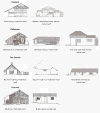Airflow attenuation and bed net utilization: observations from Africa and Asia
- PMID: 22704585
- PMCID: PMC3441282
- DOI: 10.1186/1475-2875-11-200
Airflow attenuation and bed net utilization: observations from Africa and Asia
Abstract
Background/methods: Qualitative studies suggest that bed nets affect the thermal comfort of users. To understand and reduce this discomfort the effect of bed nets on temperature, humidity, and airflow was measured in rural homes in Asia and Africa, as well as in an experimental wind tunnel. Two investigators with architectural training selected 60 houses in The Gambia, Tanzania, Philippines, and Thailand. Data-loggers were used to measure indoor temperatures in hourly intervals over a 12 months period. In a subgroup of 20 houses airflow, temperature and humidity were measured at five-minute intervals for one night from 21.00 to 6.00 hrs inside and outside of bed nets using sensors and omni-directional thermo-anemometers. An investigator set up a bed net with a mesh size of 220 holes per inch 2 in each study household and slept under the bed net to simulate a realistic environment. The attenuation of airflow caused by bed nets of different mesh sizes was also measured in an experimental wind tunnel.
Results: The highest indoor temperatures (49.0 C) were measured in The Gambia. During the hottest months of the year the mean temperature at night (9 pm) was between 33.1 C (The Gambia) and 26.2 C (Thailand). The bed net attenuated the airflow from a minimum of 27% (Philippines) to a maximum of 71% (The Gambia). Overall the bed nets reduced airflow compared to un-attenuated airflow from 9 to 4 cm sec-1 or 52% (p<0.001). In all sites, no statistically significant difference in temperature or humidity was detected between the inside and outside of the bed net. Wind tunnel experiments with 11 different mesh-sized bed nets showed an overall reduction in airflow of 64% (range 55 - 71%) compared to un-attenuated airflow. As expected, airflow decreased with increasing net mesh size. Nets with a mesh of 136 holes inch-2 reduced airflow by 55% (mean; range 51 - 73%). A denser net (200 holes inch-2) attenuated airflow by 59% (mean; range 56 - 74%).
Discussion: Despite concerted efforts to increase the uptake of this intervention in many areas uptake remains poor. Bed nets reduce airflow, but have no influence on temperature and humidity. The discomfort associated with bed nets is likely to be most intolerable during the hottest and most humid period of the year, which frequently coincides with the peak of malaria vector densities and the force of pathogen transmission.
Conclusions: These observations suggest thermal discomfort is a factor limiting bed net use and open a range of architectural possibilities to overcome this limitation.
Figures








References
-
- WHO. World malaria report 2009. World Health Oraganization, Geneva; 2009.
-
- Trape JF, Tall A, Diagne N, Ndiath O, Ly AB, Faye J, Dieye-Ba F, Roucher C, Bouganali C, Badiane A, Sarr FD, Mazenot C, Touré-Baldé A, Raoult D, Druilhe P, Mercereau-Puijalon O, Rogier C, Sokhna C. Malaria morbidity and pyrethroid resistance after the introduction of insecticide-treated bednets and artemisinin-based combination therapies: a longitudinal study. Lancet Infect Dis. 2011;11:925–932. doi: 10.1016/S1473-3099(11)70194-3. - DOI - PubMed
Publication types
MeSH terms
LinkOut - more resources
Full Text Sources
Other Literature Sources
Medical
Research Materials

